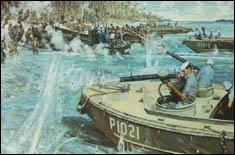Paths of Services Meet on a Bloody Beach in the Pacific
U.S. Coast Guard | PA1 Kyle Niemi | September 27, 2006
 As America's two smallest armed services, the U.S. Marine Corps and the U.S. Coast Guard have much more in common than many may think.
As America's two smallest armed services, the U.S. Marine Corps and the U.S. Coast Guard have much more in common than many may think.It's not our uniforms or our haircuts; it's not our equipment or our training.
It's our history and our traditions; it's our honor and our commitment.
Both services were established to help protect a fledgling nation, vulnerable to enemies- both foreign and domestic. Both services are on the frontlines of today's global war on terrorism- with members fighting both at home and abroad. And both services are proud of our members who paid the ultimate sacrifice having been wounded or killed in defense of our country.
Bronze Stars, Purple Hearts and Medals of Honor adorn the gravesites of both Coast Guard and Marine Corps combat veterans.
THE BIRTH OF THE UNITED STATES MARINE CORPS - THE FEW. THE PROUD.
On Nov. 10, 1775, the Continental Congress passed a resolution raising two battalions of Marines to serve as landing forces in combat. This resolution established the Continental Marines, who saw action until the Treaty of Paris ended the Revolutionary War in 1783. The treaty resulted in the disbanding of the Continental Marines and Continental Navy.
The formal re-establishment of the Marine Corps was through an act of Congress on July 11, 1798.
THE BIRTH OF THE UNITED STATES COAST GUARD - GUARDIANS OF THE SEA
Immediately following the Revolutionary War, the United States government struggled to maintain financial stability. Although import tariff laws were in place, rampant smuggling by merchants transporting cargo by sea signaled the need for strong enforcement of maritime tariffs. On Aug. 4, 1790, Congress passed the Revenue Cutter Bill, authorizing the construction of 10 armed vessels, thus establishing the Revenue Marine. The Revenue Marine cutter crews were charged with enforcing the tariffs and other maritime laws and operated as the only armed federal vessels in the nation's service for nearly 10 years; the Navy Department was not established until 1798.
Officially known as the Revenue Cutter Service since 1862, the service was merged with the U.S. Life-Saving Service in 1915 to form the U.S. Coast Guard.
BROTHERS-IN-ARMS
Marines and Coast Guardsmen can share in some of the greatest tales of heroism and sacrifice from all of the armed conflicts of our nation's history. Perhaps the best depiction of Coast Guardsmen and Marines fighting side-by-side against a common enemy was during the turbulent days of World War II.
World War II, spanning from 1939 to 1945, was a worldwide conflict the likes of which the modern world had never seen. The conflict waged between the Allied and Axis Powers in the Mediterranean Sea and the Indian, Atlantic and Pacific Oceans. No less than 56 countries were involved in air, land and sea battles in Europe, the Soviet Union, North Africa and Asia's Far East.
According to news anchor Tom Brokaw, Americans who came of age during the Great Depression and fought for our country during World War II are the "Greatest Generation." Brokaw coined the phrase in his 1998 book of the same name.
With experience navigating small vessels in heavy surf, Coast Guard coxswains manned landing craft during the amphibious operations of World War II, delivering Soldiers and Marines to the beaches in both the Atlantic and Pacific theaters. Coast Guard crews also escorted convoys, transported troops and supplies, conducted port security operations and hunted enemy submarines.
THE ULTIMATE SACRIFICE
Guadalcanal, a small island in the Solomon Islands, would be the scene of a major turning-point in the war in the Pacific. Under Japanese control, the island was chosen as the location of the first large-scale assault of a Japanese-held island.
On Sept. 27, 1942, about a month into the Guadalcanal Campaign, about 500 Marines of Lt. Col. Lewis B. "Chesty" Puller's 1st Battalion, 7th Marines were huddled on the beaches of the Matanikau River awaiting extraction from the island. Petty Officer 1st Class Douglas Munro, coxswain of a 36-foot Higgins boat, was officer-in-charge of a dozen craft from Lunga Point Base arriving to extract the Marines.
Suddenly, Japanese forces began firing intensely from a ridge about 500 yards from the beach. Steering his boat between the Marines and the Japanese forces, Munro provided cover for the landing craft, allowing the safe evacuation of all the Marines, including 25 wounded.
Once all the Marines were safely extracted, Munro and his crewman maneuvered their boat to leave. It was then that Munro was struck by enemy fire and killed instantly. Munro was posthumously awarded the country's highest honor- the Congressional Medal of Honor. He remains the only Coast Guardsman to receive the medal.
The Coast Guard also engaged in transport and escort duties for Marine forces invading the islands of Guam, Tinian, Saipan, Okinawa and the Philippines.
As brothers-in-arms during the amphibious assaults and invasions of World War II's battle for the Pacific, the Coast Guard and Marine Corps each showed why they are considered the best in the world at what they do. It's been nearly two-and-a-half centuries since history saw the birth of the Marine Corps and the Coast Guard. From the turbulent first days of our country through the first and second world wars to today's global war on terrorism, the armed forces of the United States, including the Marine Corps and the Coast Guard, will continue to answer the call to service.
No comments:
Post a Comment